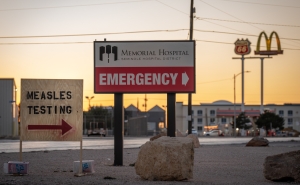The COVID-19 Questions We Don’t Have Answers For Yet

Nearly a year and a half into the COVID-19 pandemic, there are still so many unanswered questions.
INTERVIEW BY LINDSAY SMITH ROGERS
What do we know, at this point, about who is at risk of long-COVID? How much immunity is enough immunity to COVID and can we measure this? At this point, what do we know for sure about the origin of SARS-CoV-2?
In a Q&A, virologist Gigi Gronvall, PhD, from The Center for Health Security talks about what we know, what we don’t know and what research is underway to answer these and more of some of the biggest lingering questions about COVID-19.
What do we know about who is at risk of developing long-hauler COVID, and can this be prevented?
At this point, there’s no data on who is more likely to get long COVID. But there are studies underway looking at whether vaccination can help with long COVID.
It’s important to note that regardless of whether or not vaccines can help with symptoms, long-hauler COVID patients should get vaccinated for COVID. This will help prevent reinfection as we still don’t know how robust the immune response is in long-haul patients.
Anecdotally, someone I know had long COVID and his symptoms were resolved after he got vaccinated. He was concerned because he had bad side effects from the vaccine and he thought, “This is the way my life is going to be forever.” When the symptoms of the vaccine went away, his long COVID symptoms went away too. But promising anecdotes need to be backed up by data.
How much immunity is enough immunity to COVID, and can we measure this from previous infections or vaccinations?
We don’t know. We can measure antibodies after infection and it looks like after vaccination T cells are also important—maybe even more important. But we don’t have a number for any of these that tells us “this amount of immunity is sufficient.” But scientists are now thinking that immunity might persist for years.
What do we know now about the wide variety of human responses to the virus? Does more severe COVID come down to an individual’s biology, the amount of virus they are exposed to, or both?
These are all questions that are easier to answer if you have a therapy that you can actually test to monitor the course of disease. We don’t have that option with this disease.
Does it matter how much virus you’re exposed to? I think the answer is almost certainly yes. But there is a little bit of debate about that and it’s hard to test. If you get infected you can’t tell if you got a big dose of virus or not. So, I don’t think we know for sure yet.
So, if you’re vaccinated and exposed to a huge dose of the SARS-CoV-2 virus, is that where a breakthrough infection might happen because there’s so much virus?
It’s definitely possible, but it’s hard to say that that’s the cause, and it isn’t the only theoretical reason a person could have a breakthrough infection.
Although vaccines specifically target the virus that causes COVID-19, do vaccines offer some protection or relief from symptoms associated with other types of coronaviruses?
Maybe, but the COVID vaccines are very specifically created to protect against SARS-CoV-2. However, there are research groups working on a pan-coronavirus vaccine.
The CDC recently said that fully vaccinated people do not need to wear masks or social distance in most settings. But what if you have unvaccinated children at home, or an immunosuppressed person living with you? Should you still wear a mask in indoor public spaces?
Vaccinated people are not likely to transmit disease to others, including unvaccinated children. However, CDC guidance requires some more judgment about people who are at high risk and who may not be able to be vaccinated or for whom the vaccine may not work as well.
If I was living with someone who is at high risk who couldn’t be vaccinated and community transmission is high, perhaps I’d take more precautions to protect that person, including wearing a mask in areas where I might be exposed.
What do we know, at this point, about instances of myocarditis or heart inflammation in some teens after COVID-19 vaccination?
So far, we don’t have a direct link. CDC is reporting that the cases have been mild and have resolved with medicine and rest. But it is a situation to monitor and not a situation to be unduly concerned about.
Myocarditis also occurs in much higher percentages with COVID infection, even mild or asymptomatic infections. So, you can calculate that your risks of myocarditis are bigger from getting COVID than they are from getting vaccinated.
This is also the reason we have adverse event detection systems: The vaccination data is paired up with any sort of adverse event data, and then the direct link has to be made.
What do we know at this point about mixing different vaccines, i.e. one dose of Pfizer, one dose of Moderna? Is it possible to get the one-dose J&J and then get a dose of either Pfizer or Moderna as a “booster”?
There’s no reason to believe, scientifically, that this wouldn’t work. I can’t think of any adverse event that would be caused by this, but the question is whether doing this would be as effective as two doses of the same vaccine. There is a study underway to look at mixing and matching for a vaccine booster.
It’s an interesting hypothesis but that’s why you need to test it.
Where are we on the theory of COVID-19’s origin?
President Biden just issued a statement that he’s given his intelligence community 90 days to produce a report. There’s a lot of evidence that this ultimately has a natural origin. Whether or not a laboratory leak had anything to do with accelerating the pandemic or had any role in the introduction in a clinically relevant way—I personally doubt it, particularly because of the emergence of variants associated with different wildlife markets early in the pandemic.
But I don’t know if you could ever prove it to everyone’s satisfaction, and without a lot more data, we may never get a satisfactory answer. What I’m wondering now is, and what I’m interested to think about and write about, is “What happens either way?”
There are big gaps in what we know about viruses spilling over from animals. We do not take prevention as seriously as we should when it comes to interacting with the natural world, and we’re perturbing nature in all kinds of ways that make spillover more likely. Humans come into contact with diseases all the time where nobody questions the origin—SARS, MERS, and the ever-present threat of flu. We should be thinking a little more about how to prevent pandemics. Even though we’ve done an amazing job with vaccines, it certainly would be better and would save more lives to understand the human-animal interface better and make pandemics less likely.
What do we know at this point about how much of a threat the delta variant poses in terms of transmissibility and severity of disease?
The delta variant appears to be the most transmissible one yet. But, it’s challenging to say just how much because peoples’ behavior changed a lot n ways that favor viral spread at the same time. It’s also hard to tell how much more serious disease is, but on this score, most people do not think it is much if any different in severity. Either way, the vaccines available in the US are protective.
Gigi Gronvall, PhD, is a senior scholar at the Center for Health Security and an associate professor in Environmental Health and Engineering.
Lindsay Smith Rogers, MA, is the producer of the Public Health On Call podcast and the associate director of content strategy for the Johns Hopkins Bloomberg School of Public Health.





